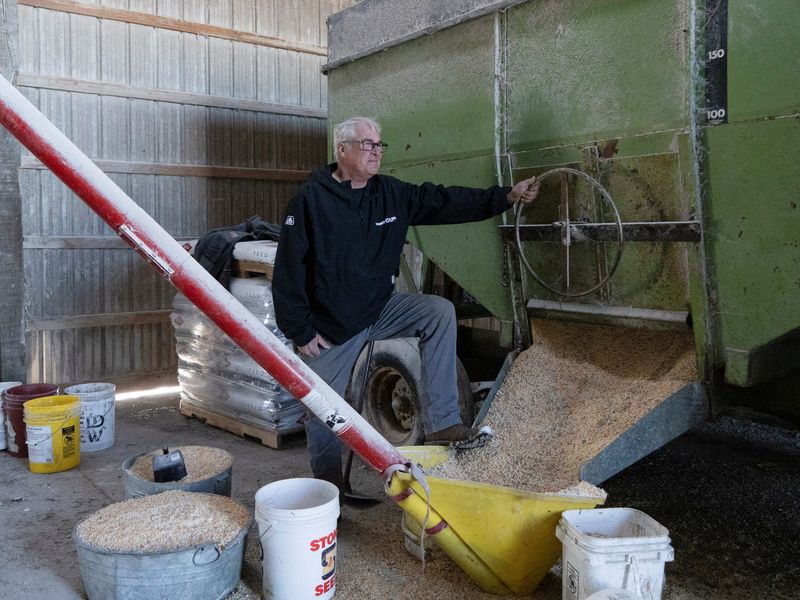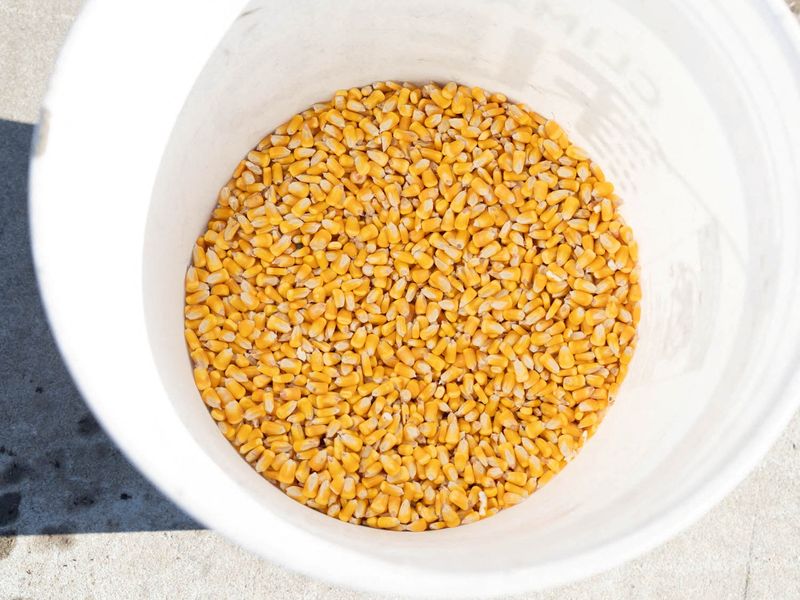By Tom Polansek
CHICAGO (Reuters) - Illinois farmer Dan Henebry regrets not selling more of his corn crop last summer, when the Midwest needed rain and prices were high.
He is not alone.
Farmers across the United States are kicking themselves for putting off corn sales after fields dried up in May and June, fueling expectations for higher prices and smaller harvests. Instead, prices tanked as rains saved the crop. The size and speed of the price collapse stung farmers and left their storage bins stuffed with record amounts of corn.
The steepest market downturn in a decade in 2023 has extended into 2024, hurting the U.S. rural economy. Two years of high prices and tight crop supplies spurred by unfavorable global weather and disruption from the Ukraine war have been quickly reversed.
Record-large harvests in the United States and Brazil, increased competition for U.S. grain exports, and limited domestic demand led to hefty amounts of corn locked away in storage, pushing U.S. corn prices to their lowest level since November 2020 on Wednesday.
Corn is the world's most traded commodity crop and often sets the tone for other crops. Soybeans, too, plummeted to their lowest prices in more than three years in February.
Ten farmers, economists and market analysts said U.S. growers miscalculated when they held on to corn rather than booking sales. The "store and ignore" strategy of waiting for higher prices has not paid off, leaving some farmers cutting back purchases of pricey equipment and planting less corn. The interviews also demonstrate the tricky decisions farmers face when determining when to sell in the face of potential crop losses.
Corn futures prices that approached $6.30 a bushel in June have since tumbled to $4.10, after U.S. farmers ultimately produced record crop yields.
"I wish I sold a lot more," Henebry said.
U.S. growers held a whopping 7.83 billion bushels of corn in storage bins on their farms as of Dec. 1, the most ever for that date and up 16% from a nine-year low in December 2022, U.S. government data show. Globally, leftover inventories are projected to reach a five-year high by September after accounting for all the corn used to feed livestock, make biofuels and other purposes.
Henebry said he still has about 40% of his 2023 harvest in storage, including 30,000 bushels on his farm in central Illinois. He is paying 3 to 4 cents per bushel a month to keep another 30,000 bushels at a local grain elevator. In a normal year, he would not have any still stored there, he said.
Before prices plunged last summer, Henebry said he sold some corn for $5.50 to $5.70 per bushel and then for as much as $6.21 per bushel delivered to the grain elevator. He held off on further sales because he was counting on poor weather to reduce production and boost prices.
Prices tumbled, though, and Henebry said he sold corn in December for $4.60 per bushel. He wishes he would have unloaded even more at that price.
Prices will come under renewed pressure as farmers do sell the grain they have in storage, analysts said.
"Any sort of little rally, there's going to be a lot of corn sold," said Henebry.
'I'LL JUST GIVE UP'
Fred Huddlestun, a farmer in Yale, Illinois, said he still had his entire 2023 corn harvest in storage last month: about 39,000 bushels at an elevator and 25,000 bushels at home. Prices never reached targets he set to make sales last year, even as he lowered them.
Huddlestun could have earned roughly $360,000 if he had struck deals to sell 64,000 bushels just after Easter; $382,000 around Father's Day in June; and $307,000 on Halloween, based on Chicago Board of Trade corn futures that represented last autumn's crop. At current prices, his grain is worth about $263,000. Futures and cash prices often differ by a few cents.
"I kept thinking the market would go up," Huddlestun said. "I'll just give up eventually and start selling if nothing happens."
Huddlestun said he should have sold around $5.50 a bushel. Though all operations are different, breakeven prices for corn growers in central Illinois were about $5.27 a bushel in 2023, including costs for land and other expenses, according to University of Illinois estimates.
Farmers have the space to squirrel away crops after increasing their storage capacity by 24% over the last two decades to 13.6 billion bushels. Storing grain gives farmers more control over when and how they sell, to avoid prices that are typically low at harvest time and to best take advantage of spikes in futures. At grain elevators and other commercial handlers, off-farm storage capacity has increased by 40% to 11.9 billion bushels over the past 20 years, according to U.S. government data.
High interest rates make storage more costly because farmers' crops are tied up in bins rather than sold to reduce debt, economists said.
In southern Illinois, the second biggest corn-producing state, farmers could actually lose up to $160 an acre growing corn this year, based on corn prices and the cost of production, University of Illinois economists said in a January report. Two years ago, profits reached about $340 an acre.
Such expected losses are rippling through rural America. Net farm income in 2024 is projected to suffer the largest year-to-year dollar decrease in history, the American Farm Bureau Federation, an industry group, said in a report this month.
Deere (NYSE:DE) & Co, the world's largest farm equipment maker, expects sales of large agricultural equipment to decline 20% this year, due to lower commodity prices and high interest rates.
'PLENTY OF CORN'
In Wamego, Kansas, Glenn Brunkow, a fifth-generation crop and livestock farmer, plans to delay upgrades to machinery and may try to repair equipment himself, rather than paying a dealership.
"We're tightening expenses as much as we can," he said. "We're trying to limp through putting off some expansion with the livestock, just trying to limp by."
Early forecasts show U.S. farmers are likely to cut back on corn planting and favor soybeans in 2024. They may struggle to turn a profit with either crop.
Brunkow said he plans to forgo corn planting entirely and grow some sorghum, which requires less fertilizer and has less expensive seeds than corn. Sorghum can be used to make ethanol, feed livestock or be exported to China to make baiju liquor.
Years ago, Brunkow gave up on growing sorghum because it produces lower yields and is difficult to dry at harvest time.
Now, "the economics just are better," he said. "You're going to lose less money."
Analysts do not expect a major bump in demand to draw down corn stockpiles. U.S. exports of agricultural and related products fell 10% by value in 2023 to a three-year low, as plentiful supplies from Brazil and elsewhere challenged U.S. export sales.
Demand from the U.S. meat industry, which feeds corn to livestock, is limited as pig farmers face lackluster pork demand while cattle ranchers slashed their herds due to drought in the Great Plains.

Biofuel demand, which typically accounts for about one-third of U.S. corn production, also worries Rod Weinzierl, executive director of the Illinois Corn Growers Association, as Americans buy more electric vehicles.
"This year every fork in the road has been bearish," said Matt Wiegand, commodity broker for risk management firm FuturesOne in Nebraska.
